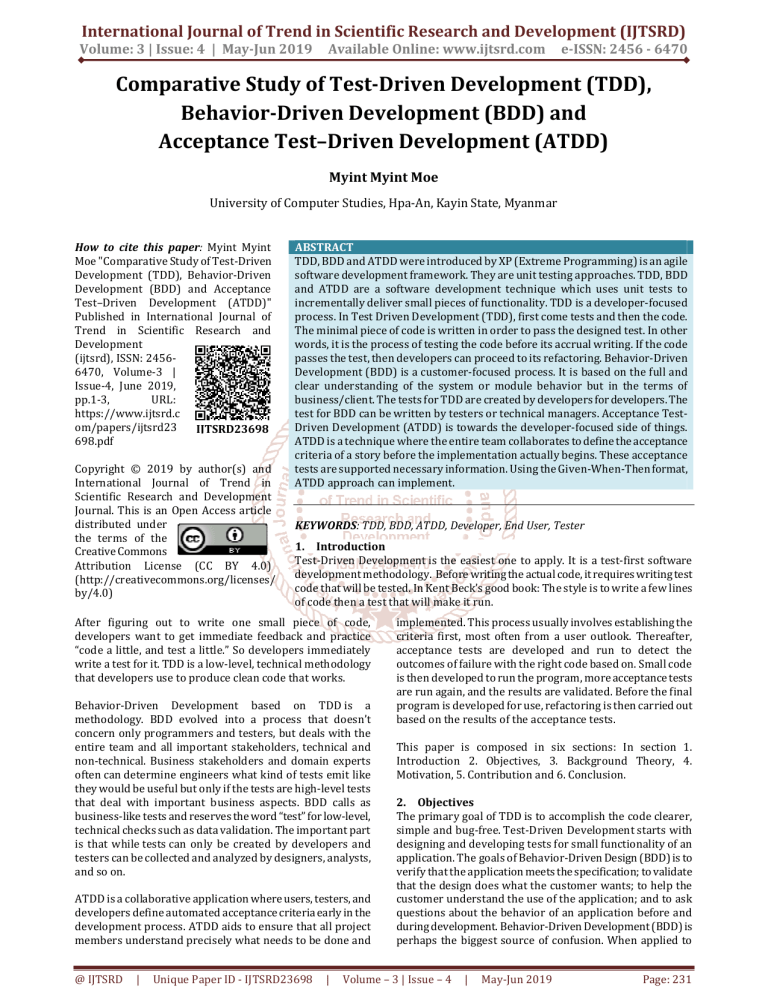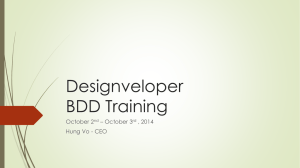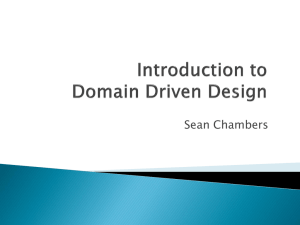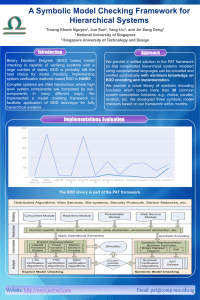
International Journal of Trend in Scientific Research and Development (IJTSRD)
Volume: 3 | Issue: 4 | May-Jun 2019
Available Online: www.ijtsrd.com
e-ISSN: 2456 - 6470
Comparative Study of Test-Driven Development (TDD),
Behavior-Driven Development (BDD) and
Acceptance Test–Driven Development (ATDD)
Myint Myint Moe
University of Computer Studies, Hpa-An, Kayin State, Myanmar
How to cite this paper: Myint Myint
Moe "Comparative Study of Test-Driven
Development (TDD), Behavior-Driven
Development (BDD) and Acceptance
Test–Driven Development (ATDD)"
Published in International Journal of
Trend in Scientific Research and
Development
(ijtsrd), ISSN: 24566470, Volume-3 |
Issue-4, June 2019,
pp.1-3,
URL:
https://www.ijtsrd.c
om/papers/ijtsrd23
IJTSRD23698
698.pdf
Copyright © 2019 by author(s) and
International Journal of Trend in
Scientific Research and Development
Journal. This is an Open Access article
distributed under
the terms of the
Creative Commons
Attribution License (CC BY 4.0)
(http://creativecommons.org/licenses/
by/4.0)
ABSTRACT
TDD, BDD and ATDD were introduced by XP (Extreme Programming) is an agile
software development framework. They are unit testing approaches. TDD, BDD
and ATDD are a software development technique which uses unit tests to
incrementally deliver small pieces of functionality. TDD is a developer-focused
process. In Test Driven Development (TDD), first come tests and then the code.
The minimal piece of code is written in order to pass the designed test. In other
words, it is the process of testing the code before its accrual writing. If the code
passes the test, then developers can proceed to its refactoring. Behavior-Driven
Development (BDD) is a customer-focused process. It is based on the full and
clear understanding of the system or module behavior but in the terms of
business/client. The tests for TDD are created by developers for developers. The
test for BDD can be written by testers or technical managers. Acceptance TestDriven Development (ATDD) is towards the developer-focused side of things.
ATDD is a technique where the entire team collaborates to define the acceptance
criteria of a story before the implementation actually begins. These acceptance
tests are supported necessary information. Using the Given-When-Then format,
ATDD approach can implement.
KEYWORDS: TDD, BDD, ATDD, Developer, End User, Tester
1. Introduction
Test-Driven Development is the easiest one to apply. It is a test-first software
development methodology. Before writing the actual code, it requires writing test
code that will be tested. In Kent Beck’s good book: The style is to write a few lines
of code then a test that will make it run.
After figuring out to write one small piece of code,
developers want to get immediate feedback and practice
“code a little, and test a little.” So developers immediately
write a test for it. TDD is a low-level, technical methodology
that developers use to produce clean code that works.
Behavior-Driven Development based on TDD is a
methodology. BDD evolved into a process that doesn’t
concern only programmers and testers, but deals with the
entire team and all important stakeholders, technical and
non-technical. Business stakeholders and domain experts
often can determine engineers what kind of tests emit like
they would be useful but only if the tests are high-level tests
that deal with important business aspects. BDD calls as
business-like tests and reserves the word “test” for low-level,
technical checks such as data validation. The important part
is that while tests can only be created by developers and
testers can be collected and analyzed by designers, analysts,
and so on.
ATDD is a collaborative application where users, testers, and
developers define automated acceptance criteria early in the
development process. ATDD aids to ensure that all project
members understand precisely what needs to be done and
@ IJTSRD
|
Unique Paper ID - IJTSRD23698
|
implemented. This process usually involves establishing the
criteria first, most often from a user outlook. Thereafter,
acceptance tests are developed and run to detect the
outcomes of failure with the right code based on. Small code
is then developed to run the program, more acceptance tests
are run again, and the results are validated. Before the final
program is developed for use, refactoring is then carried out
based on the results of the acceptance tests.
This paper is composed in six sections: In section 1.
Introduction 2. Objectives, 3. Background Theory, 4.
Motivation, 5. Contribution and 6. Conclusion.
2. Objectives
The primary goal of TDD is to accomplish the code clearer,
simple and bug-free. Test-Driven Development starts with
designing and developing tests for small functionality of an
application. The goals of Behavior-Driven Design (BDD) is to
verify that the application meets the specification; to validate
that the design does what the customer wants; to help the
customer understand the use of the application; and to ask
questions about the behavior of an application before and
during development. Behavior-Driven Development (BDD) is
perhaps the biggest source of confusion. When applied to
Volume – 3 | Issue – 4
|
May-Jun 2019
Page: 231
International Journal of Trend in Scientific Research and Development (IJTSRD) @ www.ijtsrd.com eISSN: 2456-6470
automate testing, BDD is a set of best practices for writing
great tests. BDD can use together with TDD and
unit testing methods. BDD address is implementation detail
in unit tests. The test of TDD is written to analyze the
implementation of functionality, but as the code evolves,
tests can give fail results. BDD is also a test-first approach,
but differs by testing the actual behavior of the system from
the end users perspective. ATDD intends to support
collaboration among the user, developer, and tester to
ensure that acceptance tests exist before writing any code.
The acceptance test is written from the users outlook and
function as a requirement for how the software should
function.
3. Background Theory
Test-Driven Development (TDD) is a simple process. TestDriven Development (TDD) focuses on the “inside-out”
perspective and creates tests from a developer’s perspective.
The methodology focuses specifically on unit tests. The
developer catches a requirement and then converts it into a
particular test case. Then the code is written by the
developer to pass those specific test cases only. This practice
is intended to prevent unnecessary updates that do not
address the requirements. Before writing code, TDD forces
developers to focus on product requirements, a fundamental
difference from traditional programming where unit tests
are written by developers after the writing the code.
Behavior Driven-Development (BDD) focuses on the
“outside-in” perspective. These are related to business
outcomes. The process is very similar to TDD. BDD requires
guidance from developers, testers, and users to ensure
answers a user story. BDD is largely an addition of the TDD
methodology. The developer defines a test case, tests code to
analyze that the test case will fail. Next, the code is written
by the developer necessary to pass the test case and then
tests the code to ensure compliance. BDD tests cases exist in
a way that defines the desired behavior. The clear language
of BDD test cases produces it simple for all stakeholders in a
development project to understand. Acceptance Test-Driven
Development (ATDD) is an increasingly popular
development method. ATDD is closely related to Test Driven
Development (TDD) because of its highly collaborative
approach. Acceptance Test Driven Development needs
participation from customer-facing team members to
provide end user stories to the development/testing team.
These stories are refined into Acceptance Tests that lead the
development process.
3.1 Test-Driven Development (TDD)
The TDD process is presented in Figure 1, and consists of the
following steps:
1. Select a user story,
2. Write a test that fulfills a small task of the user story and
run this test. Then produces a failed test,
3. Re-write the production code necessary to implement
the feature,
4. Execute the pre-existing tests again, where any failed
test is existent. When the code is correct, completely and
finally go to the refactoring stage.
5. As the refactoring stage is finished, the correct
production code is produced and the user can select new
user story again.
This method produces some benefits, focus on the
commitment of increasing the quality of the software
product and the productivity of programmers.
@ IJTSRD
|
Unique Paper ID - IJTSRD23698
|
Figure: 1 Test-Driven Development flow
3.2
Behavior Driven-Development (BDD)
BDD, initially proposed by Dan North, is a synthesis and
refinement of software engineering practices that help teams
generate and deliver higher quality software quickly. The
BDD process is similar to TDD and follows these steps:
1. Write a scenario;
2. Run the scenario that fails;
3. Writes the test that corresponds to the specifications of
the scenario;
4. Write the simplest code to pass the test and the
scenario, and lastly;
5. Refactor to eliminate duplication.
Figure: 2 Behavior -Driven Development flow
3.3 Acceptance Test-Driven Development
Acceptance test- driven development (ATDD) is
a development methodology based on communication
between the business customers, the developers, and the
testers. Before developers begin coding, ATDD
encompasses acceptance testing, but highlights writing
acceptance tests. The ATDD process follows these steps:
1. Select user story;
2. Write acceptance test;
3. Implement user story;
4. Run acceptance test
5. Make little change/Refactor
Volume – 3 | Issue – 4
|
May-Jun 2019
Page: 232
International Journal of Trend in Scientific Research and Development (IJTSRD) @ www.ijtsrd.com eISSN: 2456-6470
3.6 Advantages and Disadvantages of ATDD
Advantages:
Improve communication and collaboration between
project stakeholders
Shared understanding of what a successful
implementation means
Better coverage of business expectations
Faster feed back
Disadvantages:
New methodology that requires rigor and discipline
Find the right balance between people/process/tool
Figure 3: Acceptance Test- Driven Development flow
3.4 Advantages and Disadvantages of TDD
The benefits of TDD:
Helps prevents defects
Helps document code with executable examples
Helps programmers really understand their code
Helps support refactoring as needs and design changes
Encourages better design (more cohesive modules that
are loosely coupled)
Provides early warning to design problems (when they
are easier to fix)
Creates an automated regression test suite, basically for
free
Programmers learn how to write other kinds of tests
It encourages small steps and the principle that it is
easier to keep a system working
3.7 Difference between TDD, BDD and ATDD
BDD focuses on the behavioral aspect of the system
rather unlike the TDD focuses on the implementation
aspect of the system.
TDD leans towards the developer-focused side of things;
the BDD is where the step of making it more customerfocused comes in.
BDD is usually done in very English-like language, and
often with further tools to make it easy for non-techies
to understand. This permits much easier collaboration
with non-techie stakeholders, than TDD.
BDD focuses on the behavioral aspect of the system
rather than the implementation aspect of the system
that TDD focuses on. BDD provides a clearer
understanding as to what the system should do from the
perspective of the developer and the customer. TDD
only gives the developer an understanding of what the
system should do.
ATDD focuses on capturing requirements in acceptance
tests and uses them to drive the development. ATDD
focuses on external quality of the software.
ATDD leans towards the developer-focused side of
things like TDD does. The BDD is where the step of
making it more customer-focused comes in.
TDD focuses on the low level, ATDD on high level.
The drawback of TDD:
A challenge to learn
Hard to apply to legacy code
Lots of misconceptions that keep programmers from
learning it
4. Motivation
According to the study, there has found TDD compared
Traditional techniques. In addition, there has discovered
TDD compared incremental Test- Last development.
This paper describes TDD compared BDD and ATDD.
3.5 Advantages and Disadvantages of BDD
If software team plans to implement BDD, here are a few
points that will benefit the software team.
Software team is no longer defining ‘test’, but is defining
‘behavior’.
Better communication between developers, testers and
product owners.
Because BDD is explained using simple language, the
learning curve will be much shorter.
Being non-technical in nature, it can reach a wider
audience.
The behavioral approach defines acceptance criteria
prior to development.
5. Contribution
Test-driven development (TDD) is a development technique
where developer must first write a test that fails before you
write new functional code. In development approaches, tests
are written ahead of the code, but in BDD, tests are more
user-focused and based on the system’s behavior. ATDD
leans towards the developer-focused side of things. This
permits much easier collaboration with non-techie
stakeholders, than TDD. This paper investigates about TDD,
BDD and ATDD. Its study pros and cons of TDD, BDD and
ATDD. This explores differences of TDD, BDD and ATDD.
Even the best development approaches can have problems
and BDD is no exception. Some of them are:
To work in BDD, prior experience of TDD is required.
BDD is incompatible with the waterfall approach.
If the requirements are not properly specified, BDD may
not be effective.
Testers using BDD need to have sufficient technical
skills.
@ IJTSRD
|
Unique Paper ID - IJTSRD23698
|
6. Conclusion
Test-Driven Development is a process for when developers
write and run your tests. Following it produces it possible to
have a very high test-coverage. Test-coverage refers to the
percentage of codes that is checked automatically, so a
higher number is better. TDD also reduces the probability of
having bugs in developer’s tests, which can otherwise be
difficult to track down. BDD illustrates the methods of
developing a feature based on its behavior. The behavior is
Volume – 3 | Issue – 4
|
May-Jun 2019
Page: 233
International Journal of Trend in Scientific Research and Development (IJTSRD) @ www.ijtsrd.com eISSN: 2456-6470
basically explained in a very simple language which can be
understood by everyone in the team who is responsible for
the development. BDD is a better approach that BDD has
actually evolved from TDD, as a way to eliminate the
shortfalls of TDD. So there is positively no damage in
implementing both approaches – one to support the quality
of the code the developer writes, and the other to support
the behavior of the system defined by the product owner.
Acceptance
test-drive
development
makes
the
implementation process more effective. These techniques
have the same goal: write just enough code, reduce
developer efforts, build to detailed requirements and
continuously test the product to ensure it meets business
user expectations.
References
[1]. ShawetaKumar, Sanjeev Bansal; “Comparative study of
Test-Driven
development
with
Traditional
Techniques”; (IJSCE); ISSN: 2231-2307, Volume-3,
Issue-1, March 2016.
[5]. Vinai Amble; May 31, 2018;
http://dannorth.net/introducing-bdd.
[2]. Luis A. Cisneros, Marisa Maximiano, Catarina I. Reis,
José Antonio Quiña Mera; “An Experimental Evaluation
of ITL and TDD”; ICSEA 2018 : The Thirteenth
International Conference on Software Engineering
Advances; Copyright (c) IARIA, 2018. ISBN: 978-161208-668-2.
[3]. Helen Johnson, works at QATestLab; Feb 10, 2017;
www.quora.com/profile/ Helen-Johnson-76.
[6]. Manoj; November 5, 2012; September 19, 2014
https://vibhuaggarwal.wordpress.com/
[7]. Sergey Sergyenko; Updated 19 February 2014; http://
code.google.com/
[8]. Duck DuckGo; www.code.google.com/ p/concord
ion/
[9]. Shanmugam Lakshmanan;
www.codeqa.com/
March
25,
2017;
[10]. Kevin Dunne; http://www. gasymphony.com
[4]. Kamil Nicieja, CEO of Ada and author of "Writing
Great Specifications"; Feb 11, 2017;
www.quora.com/profile/
@ IJTSRD
|
Unique Paper ID - IJTSRD23698
|
Volume – 3 | Issue – 4
|
May-Jun 2019
Page: 234







